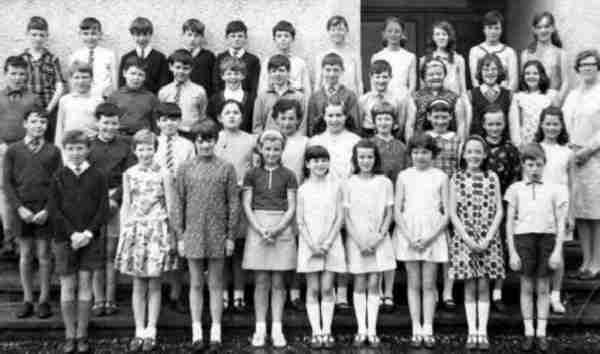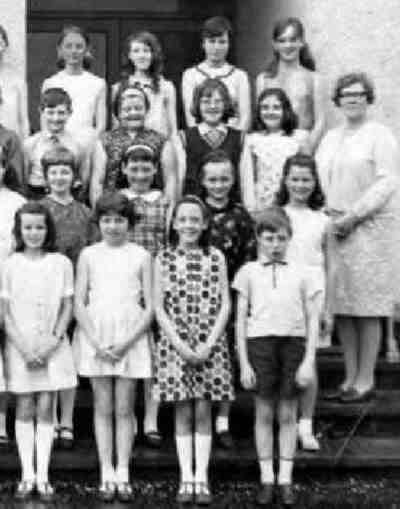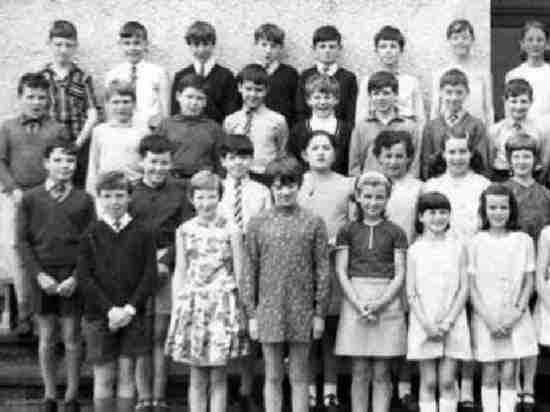
Figure 1.--This photograph shows how children at St. Patrick's Primary School dressed in 1969. This looks like one class at the school, probably the 10 year olds.


Figure 1.--This photograph shows how children at St. Patrick's Primary School dressed in 1969. This looks like one class at the school, probably the 10 year olds. |
The students at Patricks Primary School in 1969 did not have a required school uniform. About half the boys, however, wear standard school uniforms of ties and jumpers. The boys also all appear to be wearing short trousers, although, it is not clear what the boys in the back row are wearing. The girls all wear dresses--although they are not wearing any uniform style dresses like gym slips.
A Scottish primary school is for chilren about 6-11 years. Children from this school would move on to seconary school at about age 11 years. The children in this 1971 photograph look to be about 10 years old. I'm not sure what form this would have been or indeed even if the class is called a form.
Boys at St. Patrick's Primary School in 1969 did not have a required school uniform. Even so, about half wore a simple standard British school uniform, the kind that was widely available at chain stores. The other boys wear a variety of clothes--although all appear to wear short trousers. The girls are all wearing dresses.
None of the boys wear caps in the photograph. They woukld have taken them off when they arrived at school. HBC believes that by the 1969, however, that it was unlikely that the school uniform included the traditional peaked cap.
None of the boys wear blazers. While private schools for primary-age children and secondary schools usually required blazers, they were not common at primary schools. A few schools did have them, but this was the exception rather than the rule. In particular, it would be unlikely that a catholic primary school would reqwuire them as many of the children came from low-income families. While several of the boys wear ties and jumpers, none wear blazers.
The boys in the photograph wear a variety of shirts. It is difficult to tell what kind of shirts the boys wearing jumpers have. Many boys appear to be wearing white or grey shirts, but a few or wearing plaid shirts. Some boys appear to be wearing rugby-style knit shirts. Almost all of the boys are wearing long-sleeve shirts even though it does not appear to be a cold day. One boy wears a short sleeved knit Rugby-style shirt.

Figure 3.--The boys are mostly wearing grey kneesocks. One boy wears grey ankle socks. Another boy wears white ankle socks. One boy in figure 2 appears to be wearing sandals without socks. |
Quite a number of the boys are wearing ties. This is interesting for a school that did not require a uniform. Perhaps some mothers thought that their sons should wear ties for school. It is also possible that while the school did not have a required uniform that the school was incouraging the parents to wear uniform items like ties. The ties look to be identical stripped school ties.
Quite a few of the boys are wearing jumpers (pullover sweaters). They appear to be standard school uniform-type jumpers--probably grey. They are plain grey jumpers without any color trim. One boy appears to be wearing a tyrtleneck shirt with some kind of sweater with color trim. None of the girls are wearing jumpers, but one girl may be wearing a cardigan.
All of the boys appear to be wearing short trousers. While it can't be determined with certainty what the boys in the back row are wearing, the fact that all of the boys at the sides are wearing shorts, suggest that the other boys are wearing shorts. This may mean that it was a school requirement. It seems unlikely that all of the boys even in 1969 would turn up in shorts unless it was a school requirement. It is difficult to tell what kind of shorts the boys are wearing, but they are not all grey school shorts.
The girls all wear dresses. None of them wear school uniform-type dresses--in contrast to the boys, many of which are wearing uniform garments. None of the girls the kinds of informal clothes that are so common today.
Although St. Patrick's is a Scottish school, there is no indication that any of the boys were wearing kilts. Kilts were not common at any Scootish primary school known to the authors in the 1960s. Kilts were expensive and reserved for dress occasions. They were most commonly found at private schools. They were priobably even less commmon at Catholic schools because so many of the boys had Irish backgrounds and came from lower income families.
The boys wear various socks. The most common is palin grey kneesocks. They do not have colored tops, however, only a few can be seen. Boys also wear short grey socks and short white socks. The girls all wear white socks--both ankle socks and kneesocks.

Figure 4.--The girls appear to be wearing different colored shirts than most of the boys. The boys asppear to be wearing black lace up shoes. None of the children are wearing sandals. |
The boys mostly appear to be wearing dark lace-up shoes. One boy appears to be wearing schoolsandals without socks. The girls are mostly wearing sandals and strap shoes.
This photograph was probably taken in May or June. Otherwise there woul have been more boys wearing warmer shirts and jumpers. As there was no required school uniform, the children could have dressed more warmly if they had wanted.
Clearly this school did not have a uniform requirement. The school does, however, appear to have incouraged the boys to wear a uniform. The number of boys wearing proper shirts, ties, school jumpers, and shorts would surely not have been as high without some incouragment from the school.
A British reader concurs. It does look as though there was encouragement to wear a uniform. He wonders if the school was introducing uniform gradually by encouraging it for older children in 1969 while enforcing it for younger ones, so that by 1971 all children were wearing it. I think it would have been difficult to demand a new uniform for children who would wear it for only a short time, and making it voluntary might have been the answer. Of course, this is only
speculation.
An American reader reports that he went to a Catholic elementary school during the 1980s. The school had a uniform but it was not required on school picture day. He wonders if this could have been the case at St. Patrick's. HBC wonders if this was a common practice at Catholic schools. We do not believe, however, that it would have been likely at a British school. All of the Scottish and English school pictures known to the author always has the children wearing their uniforms. Also notice the 1971 and 1972 photographs at St. Patrick's has all the students in their uniforms.
Related Chronolgy Pages in the Boys' Historical Web Site
[The 1880s]
[The 1930s]
[The 1940s]
[The 1950s]
[The 1960s]
[The 1970s]
[The 1980s]
Related Style Pages in the Boys' Historical Web Site
[Long pants suits]
[Short pants suits]
[Socks]
[Eton suits]
[Jacket and trousers]
[Blazer]
[School sandals]
